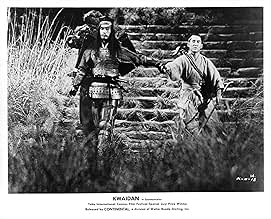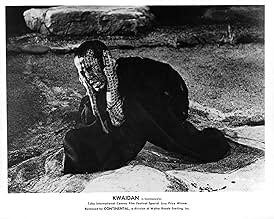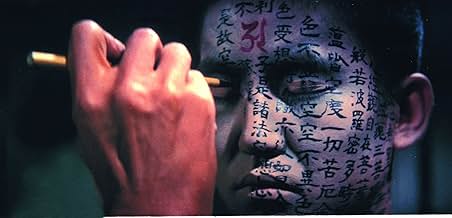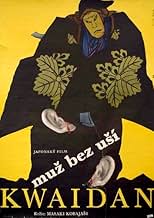NOTE IMDb
7,9/10
22 k
MA NOTE
Une collection de quatre contes folkloriques japonais avec des thèmes surnaturels.Une collection de quatre contes folkloriques japonais avec des thèmes surnaturels.Une collection de quatre contes folkloriques japonais avec des thèmes surnaturels.
- Réalisation
- Scénario
- Casting principal
- Nommé pour 1 Oscar
- 5 victoires et 2 nominations au total
Avis à la une
Four old ghost stories, updated in the late 19th Century by the Irish-Greek-America Lafcadio Hearne, then reclaimed by Kobayashi Masaki in the 1960's. This really isn't your regular horror movie to put it mildly - All four stories are told in a highly theatrical manner with deliberately stylized studios and acting. Some of the sets are very beautiful, a quite unique cinema experience.
It is, however, very uneven. The first story, 'the Woman of the Black Hair' is lovely in parts, but the ending disappoints (its different from the Lafcadio Hearne original). The second one, the 'Woman of the Snow' is genuinely very creepy and shocking. The third story, 'Hoichi the Earless' is by far the most impressive, with memorable visuals and music. The last story, 'In a Cup of Tea' is a more conventional 'tales of the unexpected' type story and is a little overlong. Its really a bit of a shaggy dog story, not worthy of the others.
There is no doubt that its a very beautiful movie in parts - some sections are genuinely memorable and will likely stick in your mind for a lot longer than the usual ghost stories. I don't think its as good a movie as some other Japanese horror movies of the period such as Onibaba or Woman of the Dunes (both made two years before this). However, it is fascinating in the little insights it gives to the pleasures of traditional Japanese theater.
It is, however, very uneven. The first story, 'the Woman of the Black Hair' is lovely in parts, but the ending disappoints (its different from the Lafcadio Hearne original). The second one, the 'Woman of the Snow' is genuinely very creepy and shocking. The third story, 'Hoichi the Earless' is by far the most impressive, with memorable visuals and music. The last story, 'In a Cup of Tea' is a more conventional 'tales of the unexpected' type story and is a little overlong. Its really a bit of a shaggy dog story, not worthy of the others.
There is no doubt that its a very beautiful movie in parts - some sections are genuinely memorable and will likely stick in your mind for a lot longer than the usual ghost stories. I don't think its as good a movie as some other Japanese horror movies of the period such as Onibaba or Woman of the Dunes (both made two years before this). However, it is fascinating in the little insights it gives to the pleasures of traditional Japanese theater.
'Kwaidan' is an astonishing film, once seen never forgotten. It's labeled horror, but while the four stories within deal with ghosts and the supernatural, I doubt that anyone would be actually frightened watching it. Haunted, yes, scared, no. It's a beautiful movie, very stylized with a very imaginative use of colour. I can't think of anything else I've seen that comes close. Mario Bava, maybe. The movie consists of four stories. I think it's best watched as a whole to let each story blend in to the other, but if forced to choose I would say my favourite segment is the second one ('The Woman In The Snow') which I believe was left out of the version of the movie originally shown outside Japan. 'Kwaidan' is one of those rare movies that leaves you stunned the first time you see it. For me it's equal to 'Rashomon', 'Woman In The Dunes' and 'Branded To Kill' as the most amazing Japanese movies I've ever seen. Each one of these movies blew my mind. It's difficult not to gush about all four. They come with my highest recommendation. I sincerely believe that anybody who watches them will be incredibly impressed. They are all masterpieces.
Kwaidan is one of the great underappreciated films: no one's heard of it, but you'll never, ever forget it once you've seen it. Parts of it may seem slow to some viewers, and most of the stories are extremely predictable, but I have to say this is one of the most beautiful, haunting movies I've ever seen.
Of all the stories I prefer "Black Hair," the first one. Though a rather pointless horseback archery scene just slows it down, it's by far the scariest and most nightmare-worthy of the stories, using sound to incredibly chilling effect. There's more terror in the last minute of this segment than in all three Scream movies put together. Trust me, if you consider yourself a serious fan of horror cinema, you have to see this.
The second story, "The Woman of the Snow," is good, though I wish it ended more like "Black Hair" (you'll see what I mean). "Hoichi the Earless," with its jaw-dropping sea battle sequence, is by far the biggest and most popular of the stories. It's also the most influential, with its main premise prominently re-used in Conan the Barbarian. The film ends with "In a Cup of Tea." This is the only story that doesn't completely telegraph its ending, and coming after three utterly predictable stories, its complexity is a bit unexpected and disorienting. Certainly it's as creepy and beautiful as the rest of the film, but I have to admit I don't really understand it.
Being a tremendous fan of elegant, understated horror movies, as well as a student of Japanese culture, I consider this film one of my all-time favorites. Granted, some viewers may be turned off by the leisurely pace and the theatrical, intentionally unrealistic sets. But this is undeniably a beautiful and chilling film, absolutely perfect to watch late at night, alone, in the dark.
Of all the stories I prefer "Black Hair," the first one. Though a rather pointless horseback archery scene just slows it down, it's by far the scariest and most nightmare-worthy of the stories, using sound to incredibly chilling effect. There's more terror in the last minute of this segment than in all three Scream movies put together. Trust me, if you consider yourself a serious fan of horror cinema, you have to see this.
The second story, "The Woman of the Snow," is good, though I wish it ended more like "Black Hair" (you'll see what I mean). "Hoichi the Earless," with its jaw-dropping sea battle sequence, is by far the biggest and most popular of the stories. It's also the most influential, with its main premise prominently re-used in Conan the Barbarian. The film ends with "In a Cup of Tea." This is the only story that doesn't completely telegraph its ending, and coming after three utterly predictable stories, its complexity is a bit unexpected and disorienting. Certainly it's as creepy and beautiful as the rest of the film, but I have to admit I don't really understand it.
Being a tremendous fan of elegant, understated horror movies, as well as a student of Japanese culture, I consider this film one of my all-time favorites. Granted, some viewers may be turned off by the leisurely pace and the theatrical, intentionally unrealistic sets. But this is undeniably a beautiful and chilling film, absolutely perfect to watch late at night, alone, in the dark.
Kwaidan is a four-segment horror anthology but you'd be hard pressed to find one more removed from the typical plastic bats and cobwebs Gothic anthologies of Amicus or Hammer. While it can be billed as a "horror" movie and it deals with the supernatural, it's not really frightening. All four segments are more like traditional Japanese folk legends about ghosts, the kind of spooky stories you could hear an elder narrating to kids around a bonfire in a village near Kyoto or the outskirts of Okinawa. However if "work of art" was a genre, Kwaidan would be among the best it had to offer.
Just two years after the seminal Seppuku which was done in stark black and white with a geometric, well disciplined style, Kobayashi returns with another tour-de-force, this time in extravagant, expressionistic colour. A visual feast proving that in the right hands style can be substance. His camera with its slow tracking shots is like a brush, painting a celluloid canvas with vivid, lush compositions and it comes as no surprise to find out that he had a background in painting. The combination of eerie, supernatural material, the dreamlike atmosphere and the use of colour in lighting and sets reminded me of the great Italian maestro, Mario Bava; although Kwaidan by no means fits in the Gothic horror mold.
Conscious of the folk legend material he's working on, Kobaysi wisely shot the movie in studio sets using large painted backgrounds that look deliberately artificial as much as they look gorgeous. In many ways, it feels like a big stageplay or an elaborate dramatic poem. In that aspect, Kwaidan takes place somewhere between the real and the mythic. A land of some other order.
The stories all revolve around ghosts and are as simple and predictable as any spooky story that you might hear as an adult. But they do a great job of providing an eerie skeleton for Kobayashi to hang on his beautiful style. Style over substance one could argue. Isn't that an erroneous statement though? By making the distinction one implies that style is somehow insubstantial to a film, something that couldn't be further from the truth. The use of colour is incredible, the lighting, at times subtle and evocative or wild and expressionistic, the slow tracking shots, long stretches of silence, a body painted with holy text, Tatsuya Nakadai looking calm and happy for a change, Tetsuro Tamba in full plate samurai armor, white ghastly faces, bodies falling in blood-red waters, a painted sunset backdrop, an intelligent play on vague endings, the minimal score, chords echoing from somewhere. Kwaidan proves that style IS substance. A visual feast by all means.
It's really a shame that Kobayashi is not as widely celebrated as Akira Kurosawa. Kwaidan is just another in a series of absolutely brilliant films he did in the 60's. Beautiful, creepy, poetic, atmospheric as hell; it is the work of a master cinematician and one of the best Japanese movies you're likely to see.
Just two years after the seminal Seppuku which was done in stark black and white with a geometric, well disciplined style, Kobayashi returns with another tour-de-force, this time in extravagant, expressionistic colour. A visual feast proving that in the right hands style can be substance. His camera with its slow tracking shots is like a brush, painting a celluloid canvas with vivid, lush compositions and it comes as no surprise to find out that he had a background in painting. The combination of eerie, supernatural material, the dreamlike atmosphere and the use of colour in lighting and sets reminded me of the great Italian maestro, Mario Bava; although Kwaidan by no means fits in the Gothic horror mold.
Conscious of the folk legend material he's working on, Kobaysi wisely shot the movie in studio sets using large painted backgrounds that look deliberately artificial as much as they look gorgeous. In many ways, it feels like a big stageplay or an elaborate dramatic poem. In that aspect, Kwaidan takes place somewhere between the real and the mythic. A land of some other order.
The stories all revolve around ghosts and are as simple and predictable as any spooky story that you might hear as an adult. But they do a great job of providing an eerie skeleton for Kobayashi to hang on his beautiful style. Style over substance one could argue. Isn't that an erroneous statement though? By making the distinction one implies that style is somehow insubstantial to a film, something that couldn't be further from the truth. The use of colour is incredible, the lighting, at times subtle and evocative or wild and expressionistic, the slow tracking shots, long stretches of silence, a body painted with holy text, Tatsuya Nakadai looking calm and happy for a change, Tetsuro Tamba in full plate samurai armor, white ghastly faces, bodies falling in blood-red waters, a painted sunset backdrop, an intelligent play on vague endings, the minimal score, chords echoing from somewhere. Kwaidan proves that style IS substance. A visual feast by all means.
It's really a shame that Kobayashi is not as widely celebrated as Akira Kurosawa. Kwaidan is just another in a series of absolutely brilliant films he did in the 60's. Beautiful, creepy, poetic, atmospheric as hell; it is the work of a master cinematician and one of the best Japanese movies you're likely to see.
10OttoVonB
A man returns to his abandoned wife seeking forgiveness and pays for his cruelty. A snow demon and a young man make a pact. A blind priest is summoned by the ghosts of dead warriors to recite the heroic battle that cost them their lives. A samurai is taunted by ghosts in his cup of tea...
Kobayashi's output has been small compared to his contemporaries' (Kurosawa, Ozu...) yet each of his films is an assault on the senses and a visual gem. After unleashing some of Japan's cinematic legends in two of the greatest samurai films ever made (Samurai Rebellion with Toshiro Mifune and the sublime Harakiri with Tatsuya Nakadai), the master moved on to the supernatural with this collection of ghost stories. Filming for the first time in color, Kobayashi wields it like few others before or since, blending spellbinding compositions together and giving us a film of a visual beauty that rivals the best of Kurosawa, Kubrick or Tarkovsky. The eerie feeling of dread is matched only by the film's sheer beauty and power, like watching a moving painting or experiencing a trance.
Kwaidan is not entertaining: it is captivating, bewitching, unique even by it's author's standards. For movie-goers, this is a unique experience. For amateurs of art, it is a feast.
Unmissable!
Kobayashi's output has been small compared to his contemporaries' (Kurosawa, Ozu...) yet each of his films is an assault on the senses and a visual gem. After unleashing some of Japan's cinematic legends in two of the greatest samurai films ever made (Samurai Rebellion with Toshiro Mifune and the sublime Harakiri with Tatsuya Nakadai), the master moved on to the supernatural with this collection of ghost stories. Filming for the first time in color, Kobayashi wields it like few others before or since, blending spellbinding compositions together and giving us a film of a visual beauty that rivals the best of Kurosawa, Kubrick or Tarkovsky. The eerie feeling of dread is matched only by the film's sheer beauty and power, like watching a moving painting or experiencing a trance.
Kwaidan is not entertaining: it is captivating, bewitching, unique even by it's author's standards. For movie-goers, this is a unique experience. For amateurs of art, it is a feast.
Unmissable!
Le saviez-vous
- AnecdotesThe four vignettes were chosen to represent the four seasons of the year.
- Gaffes(at around 2h 25 mins) In the segment "Miminashi Hôichi no hanashi", Donkai says he covered all of Hôichi's body with the sacred writing, but when Hôichi is writhing on the floor after the ghost's attack, his thighs (which in the shots were supposed to be covered by his robe) are visible for a couple of seconds and are clearly unmarked.
- Citations
Hoichi (segment "Miminashi Hôichi no hanashi"): As long as I live, I'll continue to play the biwa. I'll play with all my soul to mourn those thousands of spirits who burn with bitter hatred.
- Versions alternativesOriginally a four-episode anthology released in Japan at 183 minutes. The USA version removes the second episode, starring Keiko Kishi and Tatsuya Nakadai, in order to shorten the running time to 125 minutes.
- ConnexionsEdited into Spisok korabley (2008)
Meilleurs choix
Connectez-vous pour évaluer et suivre la liste de favoris afin de recevoir des recommandations personnalisées
- How long is Kwaidan?Alimenté par Alexa
Détails
Box-office
- Budget
- 350 000 000 JPY (estimé)
- Durée3 heures 3 minutes
- Rapport de forme
- 2.35 : 1
Contribuer à cette page
Suggérer une modification ou ajouter du contenu manquant
































